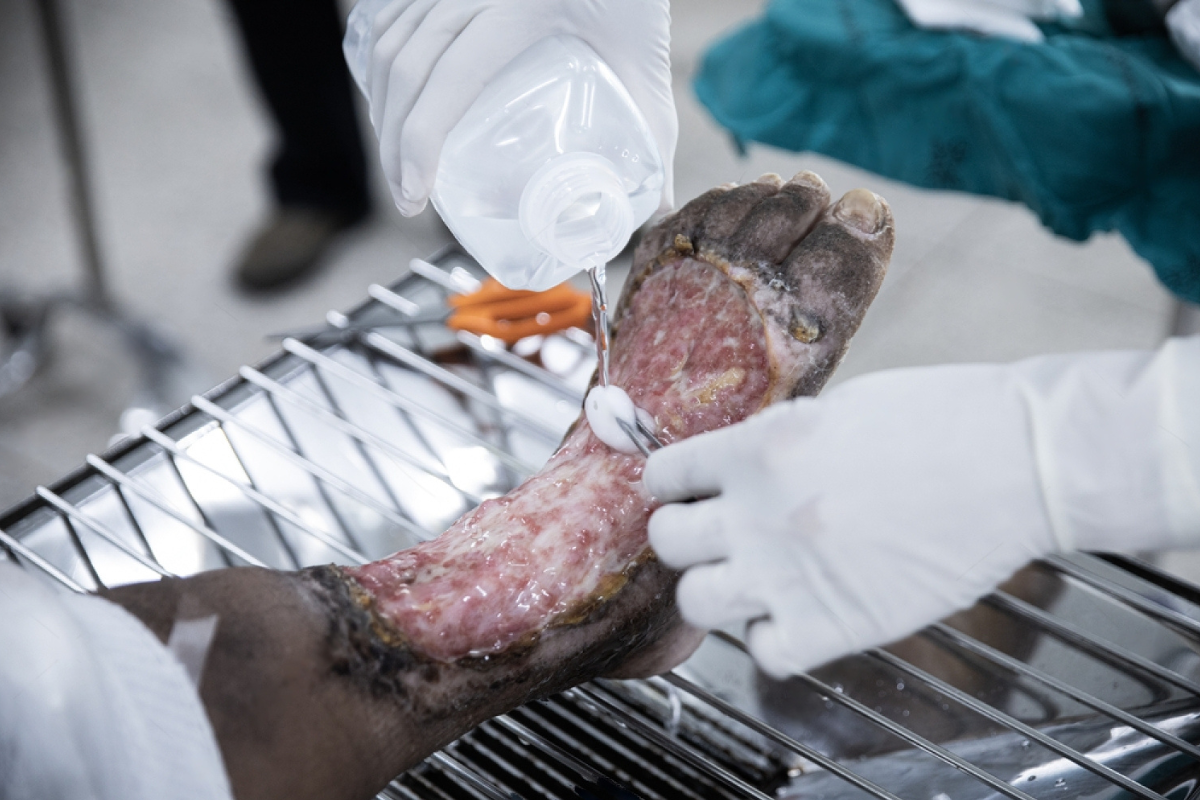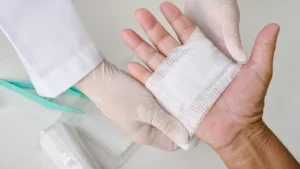Diabetic gangrene is a serious complication that occurs when tissue dies due to poor circulation, commonly affecting individuals with diabetes, especially in the lower extremities. The condition can lead to severe consequences, including infection, tissue loss, and reduced mobility. Orthopedic treatment plays a vital role in managing diabetic gangrene by addressing infection, preserving healthy tissue, and improving mobility. In this blog post, we’ll explore the importance of orthopedic care in treating diabetic gangrene and how it can help prevent further complications.
What is Diabetic Gangrene?
Diabetic gangrene is a life-threatening condition that occurs when tissues, often in the feet or lower legs, die due to insufficient blood flow, a common complication of diabetes. Poor circulation, combined with high blood sugar levels, weakens the body’s ability to fight infections, which can lead to tissue necrosis.
This condition can occur as diabetic foot complications, typically when diabetic foot ulcers or minor injuries aren’t properly managed. When gangrene sets in, the tissue becomes discolored, swollen, and painful, eventually leading to permanent damage. Without prompt treatment, it can result in amputation.
Symptoms of Diabetic Gangrene
Recognizing the early signs of gangrene is crucial for preventing more severe damage. Some common symptoms of diabetic gangrene include:
- Skin discoloration: The affected area may turn dark purple, blue, or black.
- Pain and swelling: Infected tissue becomes painful, and swelling may occur.
- Odor: A foul smell may come from the wound as the tissue begins to decay.
- Coldness: The affected area might feel cold to the touch, indicating poor circulation.
If you notice any of these symptoms in the feet or lower extremities, seek medical help immediately. Early intervention is key to preventing the spread of infection and saving tissue.
Importance of Orthopedic Treatment in Diabetic Gangrene
Orthopedic treatments are essential for managing diabetic foot care and preventing the spread of infection. Orthopedic intervention helps control the infection, preserve healthy tissue, and, most importantly, restore mobility. If left untreated, diabetic gangrene can severely impair mobility, making it difficult for patients to walk or perform daily activities.
Orthopedic care helps to manage the complications that arise from poor circulation, offering both surgical and non-surgical solutions tailored to the patient’s specific needs. By addressing the root causes of gangrene, orthopedic treatments can improve outcomes and quality of life.
Orthopedic Treatments for Diabetic Gangrene
Several orthopedic treatments are available to manage diabetic gangrene. The approach may vary depending on the severity of the condition, but common methods include:
Surgical Debridement and Tissue Removal: One of the most common orthopedic treatments for diabetic gangrene is surgical debridement, which involves the removal of dead or infected tissue to prevent the infection from spreading to healthy tissue. In some cases, amputation may be necessary if the infection has spread extensively.
Wound Care and Infection Management: Proper wound care is critical for healing. Orthopedic specialists use advanced techniques such as dressings, antibiotics, and antiseptics to manage the infection and promote healing in diabetic gangrene. Ensuring the wound stays clean and free of further infection helps reduce the risk of amputation.
Use of Specialized Orthotics and Footwear: Orthopedic footwear and custom orthotics play a crucial role in diabetic gangrene management. Proper shoes can reduce pressure on affected areas, prevent further injuries, and help maintain better circulation. Orthotics can also improve foot alignment and reduce pain, facilitating better movement and mobility.
Rehabilitation and Physical Therapy: For those who experience mobility issues due to diabetic gangrene, rehabilitation and physical therapy can assist in regaining strength, stability, and function. Orthopedic professionals design personalized programs to enhance mobility and improve quality of life, especially after significant tissue damage or surgery.
Preventing Diabetic Gangrene with Orthopedic Care
Prevention is always better than treatment, especially when dealing with diabetic foot complications. Here are some steps that can help reduce the risk of diabetic gangrene:
- Regular Foot Exams: Individuals with diabetes should perform regular foot checks to detect early signs of infection, wounds, or ulcers.
- Proper Diabetes Management: Keeping blood sugar levels under control is key to maintaining healthy circulation and preventing complications like gangrene.
- Maintaining Good Foot Hygiene: Keeping the feet clean and moisturized reduces the risk of infection.
- Wearing Proper Footwear: Comfortable, well-fitting shoes and custom orthotics can prevent injuries and help maintain proper circulation.
Taking these steps, in conjunction with orthopedic care, can greatly reduce the risk of developing diabetic gangrene.
How Orthopedic Experts at Tec Orthopedics Can Help
At Tec Orthopedics, we specialize in providing comprehensive care for diabetic gangrene. Our team of experienced orthopedic specialists is trained in managing complex foot and lower extremity conditions related to diabetes. We work closely with our patients to create personalized treatment plans, including surgical debridement, wound care, and rehabilitation therapies, to ensure the best possible outcomes.
If you or a loved one is experiencing symptoms of diabetic gangrene or has concerns about diabetic foot health, we encourage you to contact our office for an expert consultation. We are here to help manage and improve your condition, allowing you to maintain your mobility and overall health.
Takeaway
Orthopedic treatment for diabetic gangrene is critical in managing the condition, preventing complications, and restoring mobility. From early detection to advanced treatments such as surgical debridement and custom orthotics, orthopedic care plays a key role in preserving tissue and preventing amputation. By maintaining proper foot care, managing blood sugar, and seeking expert treatment early, you can significantly reduce the risks associated with diabetic gangrene.






